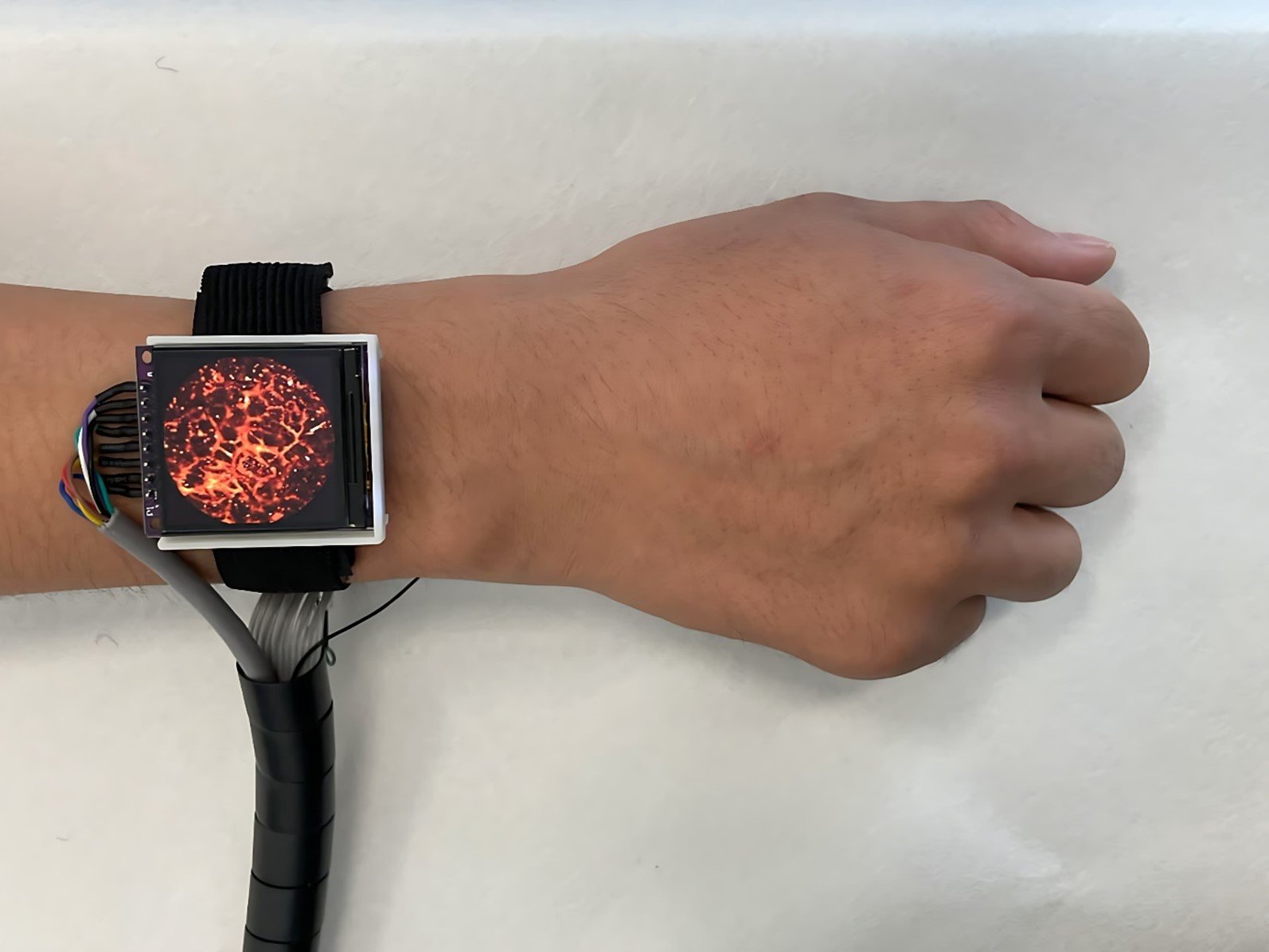Feature
Wearable watch: the photoacoustic device detecting haemodynamic changes
Chinese researchers have developed a pioneering photoacoustic watch able to produce high-resolution images of the blood vessels under the skin. This wearable wrist device offers a non-invasive, portable solution for monitoring key haemodynamic indicators. By Bernard Banga.

New Photoacoustic Watch Reveals Skin Blood Vessels in High-res Imaging. Credit: Lei Xi, Southern University of Science and Technology
Measuring heart rate, blood pressure and oxygen saturation is crucial for diagnosing and monitoring numerous cardiovascular diseases, including heart disease, peripheral vascular disease, and cerebrovascular disease. These conditions affect hundreds of millions of individuals worldwide and account for 17.9 million deaths a year. At present, the main medical imaging technologies used to measure haemodynamic parameters are ultrasound and magnetic resonance imaging. Photoacoustic imaging offers a label-free alternative, forming images by reconstructing the light energy absorption in tissue produced by generating ultrasonic waves with a laser. Analysis of the photoacoustic signal intensity and distribution provides information about the functional and structural characteristics of microvessels, which can be altered by various diseases.
OR-PAM: From research tool to wearable imaging device
A complete optical resolution photoacoustic microscopy (OR-PAM) system consists of a pulsed laser source with a driver; a complex optical pathway for laser pulse shaping and delivery; a signal processing unit with amplifiers and data acquisition capabilities; a time sequence control module for coordinating excitation, scanning and data acquisition; a computer for image storage, retrieval, and enhancement; and a power supply.
These systems are cumbersome and ill-suited to continuous mobile monitoring. ‘The bulky system and difficulties in miniaturizing and optimizing the imaging interface restrict the development of wearable photoacoustic devices for human use’, said Lei Xi, professor and deputy head of the Department of Biomedical Engineering and the Laboratory of Advanced Biomaterials at the Southern University of Science and Technology (SUSTech), Shenzhen, China. While OR-PAM thus predominantly remains a research tool, its clinical utility is emerging, particularly in vascular, cancer and dermatological imaging.
A team of SUSTech researchers has now come up with a photoacoustic device small enough to fit inside a watch for high-resolution imaging of the blood vessels under the skin. This new wearable device could offer a non-invasive way to monitor haemodynamic indicators such as heart rate, blood pressure and oxygen saturation.
A complete wearable imaging system
The researchers combined the latest developments in modern laser diode technology and electronic information technology to develop a wearable photoacoustic watch with a fully integrated OR-PAM system that is worn in a backpack suitable for an adult to carry (dimensions of 450 x 300 x 200 mm and weight of 7 kg). They have published a study of their device in the Optica Publishing Group journal Optic Letters.
The watch has dimensions of 43 x 30 x 24 mm and weighs 40 g. It also has a motorised adjustable focus enabling the imaging plane to be optimised for different individuals – a necessary feature when imaging a multilayered structure like the skin. As the author team of Lei Xi, Ting Zhang, Heng Guo and Weizhi Qi observe in their paper, the device is also able to capture microvascular details, since ‘the phantom experiments show that the watch has a lateral resolution of 8.7 µm and an active imaging area of 3 mm in diameter’. The compact backpack OR-PAM system includes a pulsed laser, a tight fibre-based light path and an electronic system. ‘The excitation laser beam is emitted from a compact 532 nm pulsed laser (FDSSS532-Q3, Crylas, Germany) with a maximum repetition rate of 2.5 kHz and a pulse width of 1.3 ns’, explained Xi. The researchers have also designed a handheld device to store images and created a miniaturised watch-type imaging interface with an adjustable focal plane and a screen for displaying the images in real time. The system is designed to be used for imaging while the wearer is freely moving around.
Promising results from a human volunteer study
‘We recruited volunteers to wear the watch and the backpack and performed in vivo imaging of the vasculatures inside human wrists under the conditions of walking and human cuff occlusion’, explained Xi. The research team assessed the watch’s focus shifting function and its capacity to longitudinally detect haemodynamic changes over an extended period and in different physiological states. These tests demonstrated that the system is suitable for different individuals, and that its compact, stable design allows free movement.
‘Miniaturized wearable imaging systems like the one we developed could potentially be used by community health centers for preliminary disease diagnosis or for long-term monitoring of parameters related to blood circulation within a hospital setting, offering valuable insights to inform treatments for various diseases’, said Xi in a press release, adding that: ‘With further development this type of system could also be helpful for the early detection of skin conditions such as psoriasis and melanoma or for analyzing burns.’
While the technology is promising, optimisation and improvement are needed in a number of areas to enable a better wearable experience and clinical compatibility. The researchers are working on a system with an even smaller laser source and a higher repetition rate with a view to making the system more compact, lighter and safer, while enhancing temporal resolution. Use of a multispectral illumination strategy should also provide information on more morphological and functional parameters.
‘It should be entirely feasible to develop a more advanced and intelligent photoacoustic watch that doesn’t require a backpack’, said Xi. The researchers are also working to ensure the fibre-coupled optical path remains stable over longer periods of time and during more intense physical activities such as running and jumping.
Unlocking clinical maturity: 3 vital upgrades for wearable imaging technology
‘It is feasible to achieve an auto adjust of the laser coupling using a motorized fiber coupling based on the real-time feedback of the output power. Finally, increasing the imaging speed with a safe laser dosage is crucial’, conclude the authors in their paper. ‘An effective approach involves controlling the laser spot scanning path along the vessels and reducing the laser dosage by significantly minimizing effective recording points.’
Medtronic offers a comprehensive RPM platform called CareLink which helps physicians, patients and carers manage health metrics and medical adherence. It has proved particularly useful in the management of diabetes. Real-time data is sent to CareLink via various devices and monitors, and patients can connect with their care team.
Accuhealth is leading on smart Bluetooth devices including blood pressure monitors, a glucose sensor, oximeter, sleep and resting heart monitor, and more. The company also offers a range of remote patient monetary vendor tools and focuses on international outreach with many of its digital technologies available in multiple languages.
Boston Scientific’s LATITUDE is a popular home monitoring system that provides doctors with access to healthcare data from certain cardiac implants such as pacemakers and defibrillators. The technology can detect the tiniest of changes in cardiac function and immediately warn the patient and clinician of impending heart failure
“Major players in the wearable technology market, such as Sony, Apple, Samsung Electronics, Xiaomi, Huawei, Garmin, among others, are also expected to drive growth in the global wearable tech market,” predicts Garcia. “Their proficiency in developing innovative wearable technology together with the incorporation of AI capabilities puts them in a strong position to take advantage of the growth in the RPM market.”
Key players include Medtronic, Accuhealth and Boston Scientific
says Elia Garcia, a GlobalData analyst

Caption: The US Pentagon is seeking to reduce carbon emissions through a range of programmes, but will it go far enough? Credit: US DoD
Total annual production

$345m: Lynas Rare Earth's planned investment into Mount Weld.

Caption. Credit:

Phillip Day. Credit: Scotgold Resources